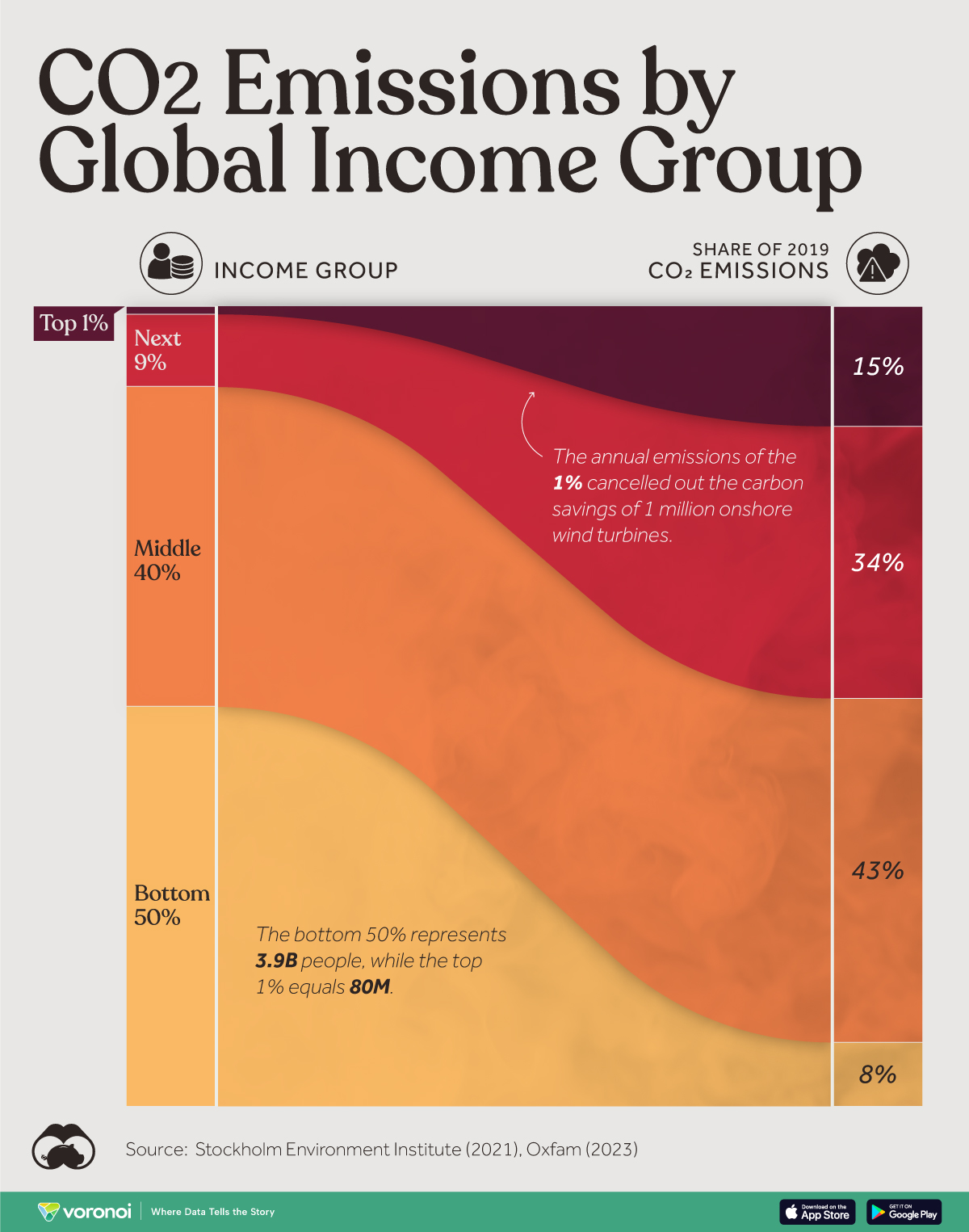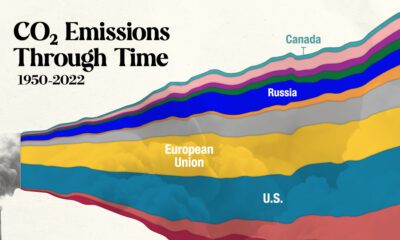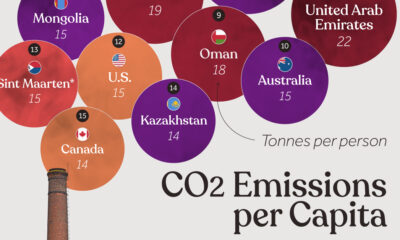Green
Charted: Global CO2 Emissions by Income Group

Global CO2 Emissions by Income Group
From a historical perspective, the current demand for natural resources has surged to unprecedented levels and continues to escalate—for both essential needs like food, clothing, water, housing, infrastructure, and non-essential consumption in everyday life.
This surge has been accompanied by annual increases in CO₂ emissions. Consumption, however, differs radically depending on income.
In this graphic, we visualize global CO₂ emissions in 2019, broken down by income group. This data comes from the Emissions Inequality Calculator, created by the Stockholm Environment Institute.
Wealthier Families Contribute More to CO₂ Emissions
In 2019, the world’s richest 1% (with an average income of $310K) were responsible for 15% of global CO₂ emissions.
The annual emissions of the 1% in 2019 canceled out the carbon savings of 1 million onshore wind turbines. In contrast, the bottom 50% (with an average income of $2,000) were responsible for only 8% of CO₂ emissions.
Here is the breakdown of emissions by income group in 2019, with average income in 2011 purchasing power parity USD:
| Income Group | Average income (USD) | Share of CO₂ Emissions |
|---|---|---|
| Top 1% | $310K | 15% |
| Next 9% | $90K | 34% |
| Middle 40% | $16K | 43% |
| Bottom 50% | $2K | 8% |
The reason for such disparity lies in consumption. For example, fashion is one of the most demanded industries in the world’s high-income countries. According to the UN, the fashion industry produces between 2% to 8% of global carbon emissions.
Another major contributor is the transport sector, which is more prevalent in developed countries. Greenhouse gas emissions from the transport sector alone have more than doubled since 1970, with around 80% of this increase coming from road vehicles.
Higher-income families also spend more on food, contributing to CO₂ emissions. The production, transportation, and handling of food generates significant CO₂ emissions. In addition, when food ends up in landfills, it also generates methane.
According to the U.S. Environmental Protection Agency, each year, U.S. food loss and waste embodies 170 million metric tons of carbon dioxide equivalent GHG emissions (excluding landfill emissions)—equal to the annual CO₂ emissions of 42 coal-fired power plants.
Green
The Carbon Footprint of Major Travel Methods
Going on a cruise ship and flying domestically are the most carbon-intensive travel methods.

The Carbon Footprint of Major Travel Methods
This was originally posted on our Voronoi app. Download the app for free on iOS or Android and discover incredible data-driven charts from a variety of trusted sources.
Did you know that transport accounts for nearly one-quarter of global energy-related carbon dioxide (CO₂) emissions?
This graphic illustrates the carbon footprints of major travel methods measured in grams of carbon dioxide equivalent (CO₂e) emitted per person to travel one kilometer. This includes both CO₂ and other greenhouse gases.
Data is sourced from Our World in Data, the UK Government’s Department for Energy Security and Net Zero, and The International Council on Clean Transportation, as of December 2022.
These figures should be interpreted as approximations, rather than exact numbers. There are many variables at play that determine the actual carbon footprint in any individual case, including vehicle type or model, occupancy, energy mix, and even weather.
Cruise Ships are the Most Carbon-Intensive Travel Method
According to these estimates, taking a cruise ship, flying domestically, and driving alone are some of the most carbon-intensive travel methods.
Cruise ships typically use heavy fuel oil, which is high in carbon content. The average cruise ship weighs between 70,000 to 180,000 metric tons, meaning they require large engines to get moving.
These massive vessels must also generate power for onboard amenities such as lighting, air conditioning, and entertainment systems.
Short-haul flights are also considered carbon-intensive due to the significant amount of fuel consumed during initial takeoff and climbing altitude, relative to a lower amount of cruising.
| Transportation method | CO₂ equivalent emissions per passenger km |
|---|---|
| Cruise Ship | 250 |
| Short-haul flight (i.e. within a U.S. state or European country) | 246 |
| Diesel car | 171 |
| Gas car | 170 |
| Medium-haul flight (i.e. international travel within Europe, or between U.S. states) | 151 |
| Long-haul flight (over 3,700 km, about the distance from LA to NY) | 147 |
| Motorbike | 113 |
| Bus (average) | 96 |
| Plug-in hybrid | 68 |
| Electric car | 47 |
| National rail | 35 |
| Tram | 28 |
| London Underground | 27 |
| Ferry (foot passenger) | 19 |
| Eurostar (International rail) | 4.5 |
Are EVs Greener?
Many experts agree that EVs produce a lower carbon footprint over time versus traditional internal combustion engine (ICE) vehicles.
However, the batteries in electric vehicles charge on the power that comes straight off the electrical grid—which in many places may be powered by fossil fuels. For that reason, the carbon footprint of an EV will depend largely on the blend of electricity sources used for charging.
There are also questions about how energy-intensive it is to build EVs compared to a comparable ICE vehicle.
-

 Education1 week ago
Education1 week agoHow Hard Is It to Get Into an Ivy League School?
-

 Technology2 weeks ago
Technology2 weeks agoRanked: Semiconductor Companies by Industry Revenue Share
-

 Markets2 weeks ago
Markets2 weeks agoRanked: The World’s Top Flight Routes, by Revenue
-

 Demographics2 weeks ago
Demographics2 weeks agoPopulation Projections: The World’s 6 Largest Countries in 2075
-

 Markets2 weeks ago
Markets2 weeks agoThe Top 10 States by Real GDP Growth in 2023
-

 Demographics2 weeks ago
Demographics2 weeks agoThe Smallest Gender Wage Gaps in OECD Countries
-

 Economy2 weeks ago
Economy2 weeks agoWhere U.S. Inflation Hit the Hardest in March 2024
-

 Green2 weeks ago
Green2 weeks agoTop Countries By Forest Growth Since 2001














